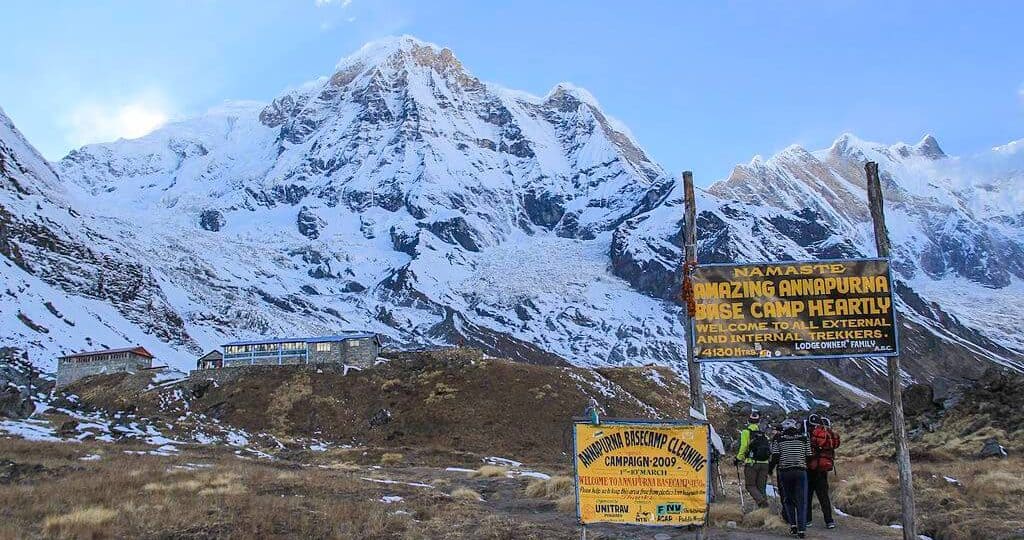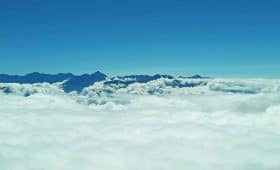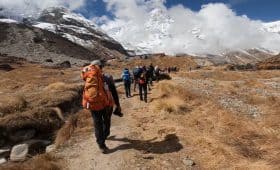Nepal has four major seasons: Autumn, Summer, Spring, and Winter. But, for avid trekkers, trekking in Nepal is possible at any time of year.
Visitors arriving in Nepal have different purposes and most of them come here to enjoy mesmerizing landscapes and viewing Himalayan peaks. Others wishes to experience the love and hospitality that Nepal and Nepalese has on offer.
Annapurna Base Camp trek is among the most popular treks in Nepal. Thousands of trekkers visit this region every year to enjoy its priceless beauty.
In this post, we are going to cover everything you need to know about the best time to trek Annapurna Base Camp.
Please have a look.
Table of Contents
Different Seasons for Annapurna Base Camp Trek
Spring (March to May)
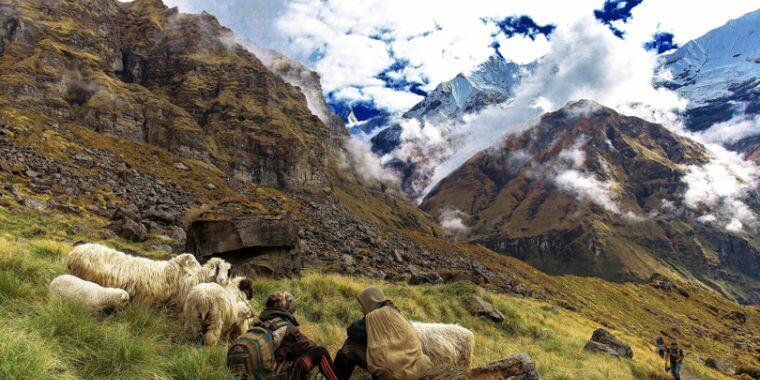
Spring is considered to be the peak trekking season in Nepal. According to statistics from Nepal Tourism Board, a whopping 27% of total visitors come to Nepal during this time of the year.
This data depicts Spring as the most favored period for trekking in Nepal. Spring has weather conditions quite similar to that of Autumn with comparatively higher temperature. The weather is good with a clear blue sky and excellent visibility.
Annapurna Conservation Area, this is where Annapurna Base Camp is, comes to life during this time. Trekking during this time is pleasant experience. Forests and surrounding hills are gorgeously green. Clear visibility provides views of glorious peaks like Annapurna massif, Machpuchhre, Himchuli, Gangapurna and many others.
In the higher regions, snowfall is common during early Spring. While the chances of rainfall are less, there is occasional snowfall during night time but starting April snowfall is less likely to happen. From May, you should expect some occasional light rain (drizzles).
Spring is the time when Nepal celebrates the New Year according to its traditional Nepali calendar. Plants grow, and flowers bloom during this time. It is also breeding season for some animals. There’s a new wave of energy flowing during Spring. Nepal celebrates other festivals like Holi, Bisket Jatra, and Ram Navami during Spring season.
Climate Table for ABC trek in Spring
| Temperature | ||||
| Name of the Place | Minimum(℃) | Maximum(℃) | Average(℃) | Precipitation(maximum) |
| Annapurna Base Camp | -8 | 14 | 3 | 120mm |
| Pokhara | 12.8 | 29.8 | 21.3 | 312mm |
| Kathmandu | 8.1 | 28 | 18.05 | 116mm |
Pros of Annapurna Base Camp Trek in Spring
- Clear visibility offers picturesque views of Himalayan mountains.
- Forests and wildlife are luxuriant.
- The temperature is comparatively warmer and perfect for a comfortable walk throughout the day and a cozy sleep at night.
Cons of ABC trek in Spring
- The early days of March are still cold.
- The number of trekkers in the trails is high. Thus, the accommodation needs to be pre-booked and usually shared with other trekkers from Sinwa onward.
Summer/Monsoon (June-August)

The summer season in Nepal is also the time for monsoon rain. So basically, this is the hottest and the wettest time in Nepal.
June starts cold, gradually getting hotter. July marks the transition month between Summer and Monsoon. August is the wettest of all.
Visibility is low during the day with clouds covering the surrounding. Trekking forest trails in monsoon might be a risky thing as the trails are slippery and prone to landslides. Besides that, leeches and mosquitoes (at lower elevation) make it bit more uncomfortable. Annapurna Base Camp trek involves trekking through the forest for most of the trail.
The mornings are bright though. It usually rains during the night. This results in a clear sky and excellent visibility, usually, in the morning. The temperature and precipitation both are high in the lower regions. At higher altitudes, things are better than in the lower areas during monsoon.
Climate Table for ABC in Summer/Monsoon
| Temperature | ||||
| Name of the Place | Minimum(℃) | Maximum(℃) | Average(℃) | Precipitation(maximum) |
| Annapurna Base Camp | 0 | 19 | 9 | 136mm |
| Pokhara | 20.7 | 29.7 | 25.2 | 876mm |
| Kathmandu | 19.1 | 28.1 | 23.6 | 379mm |
Pros of ABC trek in Summer
- Less crowded trails offer a secluded experience of trekking in the Annapurna region.
- Lush green forests and surrounding hills look vibrant and colorful.
- Locals are at rest during this Summer/Monsoon. This will help you get a good insight into the local culture and lifestyle.
Cons of ABC trek in Summer
- Trails might be in bad condition due to rain and landslides.
- Leeches and mosquitoes suck, literally.
- Poor visibility of Snow capped Himalayas.
Autumn (September-November)
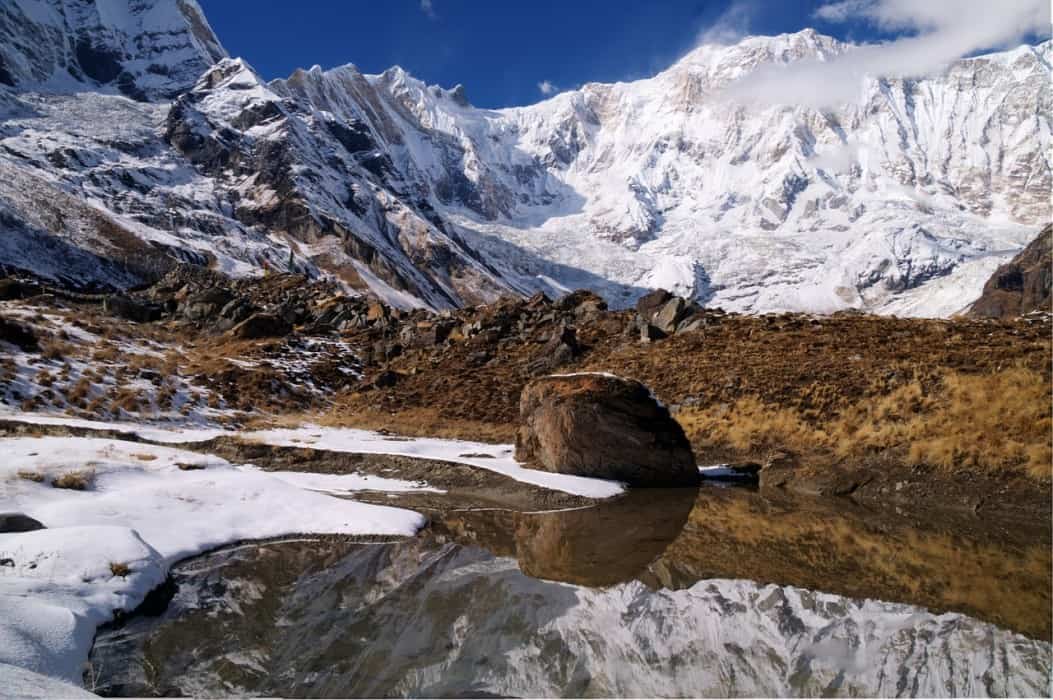
The best time to trek Annapurna is undoubtedly in Autumn. Between September, October, and November Nepal welcomes a considerable number of trekkers. For all trekking trails in the country, autumn is the best season to trek in Nepal.
32% of the total number of trekkers visit the Annapurna Conservation Area during this season according to Nepal Tourism Board.
During early September, there are still chances of rainfall. It gets drier by the end of September. October is the best month for trekkers. The temperature is comparatively warm, making it comfortable for walking in the day time. Whereas the mornings and nights are perfectly chilly.
By the end of November, the winter season shows its effect resulting in lower temperatures at higher altitudes. Clear visibility offers stunning views of peaks like Annapurna mountain range, mount Machapuchhre, Himchuli, Gangapurna and many more. Forests and Flowers add beauty on the trail.
Major festivals in Nepal fall during this time. There is a joyous environment all around. You can closely experience the local culture and traditions.
Climate Table for ABC in Autumn
| Temperature | ||||
| Name of the Place | Minimum(℃) | Maximum(℃) | Average(℃) | Precipitation(maximum) |
| Annapurna Base Camp | -10 | 20 | 5 | 62mm |
| Pokhara | 11.6 | 28 | 19.8 | 491mm |
| Kathmandu | 7.6 | 26.2 | 16.9 | 212mm |
Pros of ABC trek in Autumn
- Delightful weather makes walking easy with the warm temperature and astonishing visibility.
- There will be plenty of fellow trekkers to accompany you during the trek.
- Festivals add happiness and joy.
Cons of ABC trek in Autumn
- Sometimes the trails are too crowded. For someone who loves to trek in solitude, this is not a good time to travel.
- Accommodation are usually shared with other trekkers, usually above Sinuwa.
Winter (December-February)
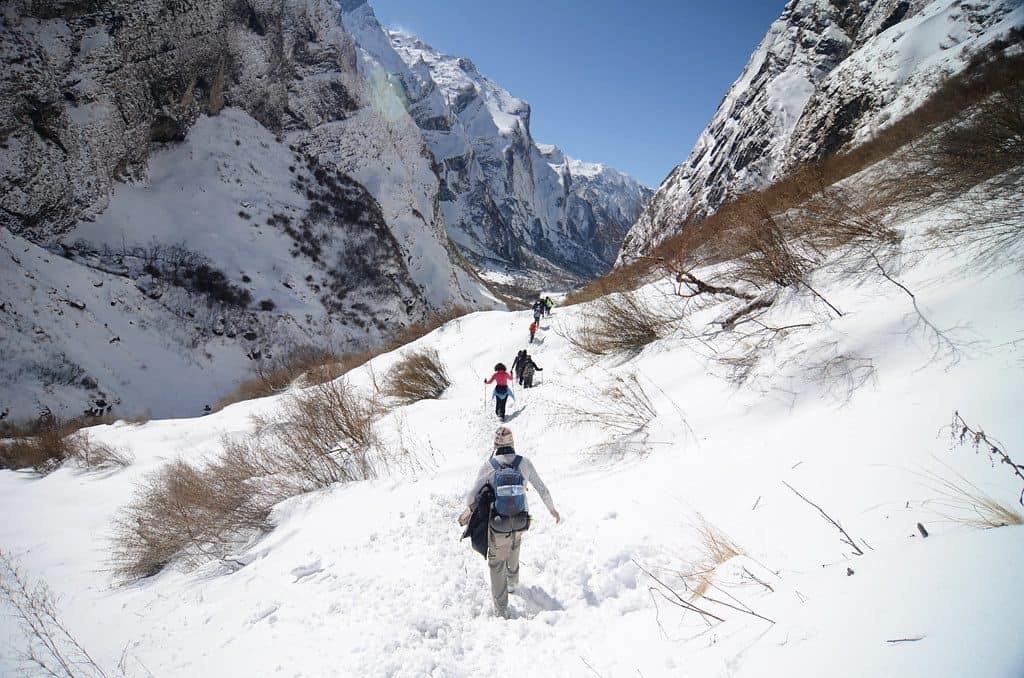
Winter in Nepal falls between December, January, and February. During Winter, high altitude passes remain closed due to extreme weather conditions.
Fortunately, the Annapurna Base camp remains open throughout the year. The temperature during this time of year is freezing cold in the higher regions reaching way below zero degrees Celsius. But, with proper preparation, Annapurna Base Camp trek 5 days or long than that is still doable during winter season.
The precipitation during these months is relatively low. Chances of rainfall or clouds covering the sky are minimal.
The wind is an important factor too. During Winter, the speed of wind in the Annapurna Base Camp region reaches as high as 38 kilometers per hour.
Shivaratri, Tamu Loshar and Udhauli are some festivals you might experience during Winter in Nepal.
Climate Table for ABC in Winter
| Temperature | ||||
| Name of the Place | Minimum(℃) | Maximum(℃) | Average(℃) | Precipitation(maximum) |
| Annapurna Base Camp | -20 | 9 | -5.5 | 14mm |
| Pokhara | 7.3 | 21.2 | 14.25 | 28mm |
| Kathmandu | 3.1 | 19.3 | 11.2 | 20mm |
Pros of ABC trek in Winter
- The trails are less crowded, offering solitude in trekking.
- Ethnic groups living in the Himalayas celebrate their significant festivals during this time.
- Clear visibility offers a picturesque view of peaks and villages.
Cons of ABC trek in Winter
- Snowfall might cause blockade of trails in the higher altitude.
- You might need to carry extra clothing and gears as it is extremely cold high up in the mountains.
Conclusion
Annapurna Base Camp trek is doable at any time of year. ABC trek has something new to offer in every season.
Best time to trek Annapurna Base Camp depends on the purpose and preference of the trekker. For people who love to trek in less crowded trails, monsoon and winter seem ideal. But, if you want to trek during the peak season and enjoy the crystal clear unobstructed views, spring and autumn is the right time for you.

Madhav started working as a porter in 2001 and then moved on to work as a trekking guide. After working in the trekking and tourism industry for eight years, he co-founded Mosaic Adventure in 2009.
Madhav has trekked to most of the trekking destinations in Nepal, including Everest Base Camp Trek, Annapurna Base Camp, Annapurna Circuit Trek, Poon Hill Trek, Jomsom Muktinath Trek, Indigenous Peoples Trek, Langtang Valley Trek, Mardi Himal Trek, and all of the day hikes around Kathmandu.
He has also extensively traveled to other countries such as Australia, the USA, the UK, France, Hong Kong, Japan, China, the Philippines, the UAE, Saudi Arabia, Bahrain, Thailand, Turkey, and India. Madhav is the one who answers most of your questions about trekking and tours and helps to plan your trip by giving a personal touch.

